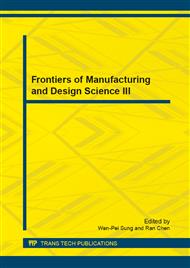[1]
S.H. Kim, S. Hashi, and K. Ishiyanma. Centrifugal force based magnetic micro-pump driven by rotating magnetic fields, Journal of Physics: Conference Series 266012072(2011).
DOI: 10.1088/1742-6596/266/1/012072
Google Scholar
[2]
Z. Yun, Z. L. Gong, and J.P. Tan. Development and Expectation of Rotary Impeller Blood Pump, Journal of Biomedical Engineering, vol. 22(2005), pp.151-154.
Google Scholar
[3]
J.T. Zhang, D. Xia. Study on magnetic gears applied in artificial hearts, mico special motors, vol. 33(2005), pp.5-7.
Google Scholar
[4]
W. Huang , and J. P. Tan. Finite element analysis of magnetic filed of permanent magnet in micro axial flow blood pump, Machinery, vol. 33(2006), pp.30-32.
Google Scholar
[5]
Y. Xu, J.P. Tan, and Y.L. Liu. Calculation method of driving torque of the large gap magnetic drives system, Jounal of Hunan University(Natural Sciences), vol. 36(2009), pp.30-36.
Google Scholar
[6]
K. Tsurumoto. Basic analysis on transmitted force of magnetic gear using permanent magnet, IEEE Trans. Magnetics, vol. 7(1992), pp.447-452.
DOI: 10.1109/tjmj.1992.4565421
Google Scholar
[7]
Y.M. Du, N.Q. Jin, and L.M. Shi. Research on magnetic force characteristics of the controlled-PM maglev linear synchronous motor with finite element method. International Journal of Applied Electromagnetics and Mechanics, vol. 33(2010).
DOI: 10.3233/jae-2010-1185
Google Scholar
[8]
S. Sanz, G. Luis, and I. Moya. Evaluation of magnetic forces in permanent magnets, IEEE Trans. Magnetics, vol. 20(2010), pp.846-850.
DOI: 10.1109/tasc.2009.2038933
Google Scholar
[9]
S.Q. Mei, Z.M. Zhang, and Z.F. Song. Design of magnetic transmission mechanism and study on calculation method of transmitted torque, Jounal of Wuhan University of Science and Enginneeing, vol. 28(2008), pp.92-96.
Google Scholar
[10]
R.F. Liu, Research on permanent magnet equivalent model in electromagnetic field computations, Joural of Beijing Jiaotong University, vol. 32(2008), pp.94-97.
Google Scholar
[11]
E.P. Furlani. A two-dimensional analysis for the coupling of magnetic gears, IEEE Trans. Magnetics, vol. 33(1997), pp.2317-2321.
DOI: 10.1109/20.573848
Google Scholar


